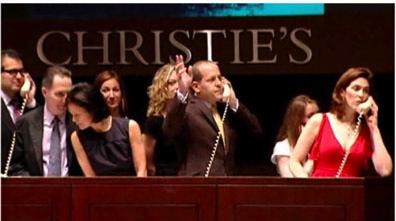CHINA’S leaders have tried honoring Ai Weiwei and bribing him with the offer of high positions. They have tried jailing him, fining him and clubbing him so brutally that he needed emergency brain surgery. In desperation, they have even begged him to behave — and nothing works.
What is the Politburo to do with a superstar artist with a vast global audience like Ai (whose name is pronounced EYE Way-way), who makes a video of himself dancing “Gangnam style” with handcuffs — parodying the Chinese state — that quickly ends up with more than one million views on YouTube?
How should the Central Committee of the Communist Party react when Ai releases a nude self-portrait with a stuffed animal as a fig leaf? The caption was “grass-mud-horse in the center” — a homonym in Chinese for a vulgar curse against the Communist Party’s central leadership. Or, more precisely, against its mother.
One thing the party detests even more than being denounced is being mocked, and humor is the signature element of Ai’s assaults. Other dissidents, like the great writer Liu Xiaobo, a Nobel Peace Prize winner now in prison, write eloquently of democracy but gain little traction among ordinary Chinese: Ai’s artistic work also seems incomprehensible to many people, but obscene jokes about grass-mud-horses can get more traction — and be difficult to quash.
“I think they don’t know how to handle someone like me,” Ai said in an interview. “They kind of give up managing me.”
One challenge for the Communist Party is that Ai, 55, is one of the world’s great artists. He also comes from a family with close ties to the Communist revolution, and his mother and father were friendly with the parents of China’s new top leader, Xi Jinping.
Ai’s emergence as an icon of resistance represents progress in China, a reflection of an unofficial pluralism that is gaining ground. China increasingly reminds me of South Korea or Taiwan in the early 1980s, when an educated middle class was nibbling away at dictatorship.
There is real improvement in China, Ai acknowledges, and he says that he expects democracy to reach China by 2020 — but he laments that it is already overdue. “They have wasted a whole generation of young people,” he said.
Ai’s irreverence seems shaped by the dozen years he spent in New York City burnishing his artistic reputation. He returned to China in 1993, at the age of 36, and initially behaved himself politically and played a role in designing the magnificent Bird’s Nest stadium for the 2008 Olympic Games in Beijing.
One factor that changed him was the terrible earthquake of 2008 in Sichuan Province in the southwest, when schools collapsed and the government clamped down on parents protesting shoddy construction. Ai backed the parents and began to demand more openness from the government.
Angered by his antagonism, the authorities had Ai beaten up and then destroyed his studio in Shanghai. Then last year the government detained him for nearly three months.
The authorities still block him from traveling abroad, so he is not able to attend a major exhibition of his work now under way at the Smithsonian’s Hirshhorn Museum in Washington.
The pressure left Ai feeling more strongly than ever that one of China’s biggest problems is autocratic government. He became more outspoken, not less.
“At every step, they pushed me into it,” he said. “I told them, ‘You create people like me.’ ”
After briefly lying low after his imprisonment, Ai has resumed his political pranks. Mocking the authorities for installing 15 cameras to monitor his movements, he broadcast a public “weiweicam” on the Internet with a feed from his bedroom so the government could keep an even closer eye on him.
“They almost begged me to turn it off,” he said with a grin.
At the end of a long conversation, I asked Ai if he had anything else to say.
“China still needs help from the U.S.,” he said. “To insist on certain values, that is the role of the U.S. That is the most important product of American culture. When Hillary Clinton talks about Internet freedom, I think that’s really beautiful.”
There’s a message there for Americans. We have a powerful military, yes, but the “hard power” of missiles is often exceeded by our “soft power” of ideas. Speaking up for our values around the world invariably raises questions of hypocrisy and inconsistency, but it’s better to be an inconsistent advocate of democracy and human rights than to be a consistent advocate of nothing.
I hope the White House listens to how Ai responded when I asked if President Obama was doing enough to raise human rights concerns.
“I don’t know what they’re doing under the table,” Ai said. “But on the surface, they’re not doing enough.”


































![[image]](http://si.wsj.net/public/resources/images/AR-AA426A_Art4_G_20121115225147.jpg) Christie's
Christie's